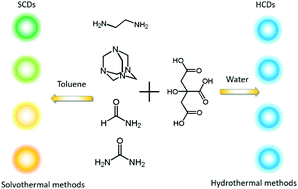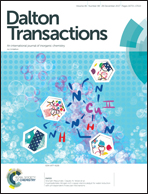A facile and universal strategy for preparation of long wavelength emission carbon dots†
Abstract
Carbon dots (CDs) have emerged as a promising new type of fluorescent nanomaterial, although one of their main problems is the tuning of the emission wavelength toward the long wavelength region. In this work, the influence of reaction solvents to emission of CDs was systematically studied using four groups of classical precursors (citric acid individually mixed with four nitrogenous organic compounds). Water and toluene were selected to represent the hydrophobic and hydrophilic reaction medium, respectively. It is interesting to observe that in toluene solvent, all the CD products yield two emission bands of blue and yellow light, and the relative intensity of the yellow to blue can be finely tuned by the precursors. In contrast, the CDs formed in water only demonstrate blue emission. Systematic studies indicate that the spectral change results from the content control of carbogenic/defect states to surface states and the energy transfer from the carbogenic/defect states to the surface states. Moreover, solid-state luminescent CD-polymers were fabricated that also demonstrated continuously tunable emission properties. This work provides a new strategy for recognizing the generation of long wavelength-emitting CDs.



 Please wait while we load your content...
Please wait while we load your content...